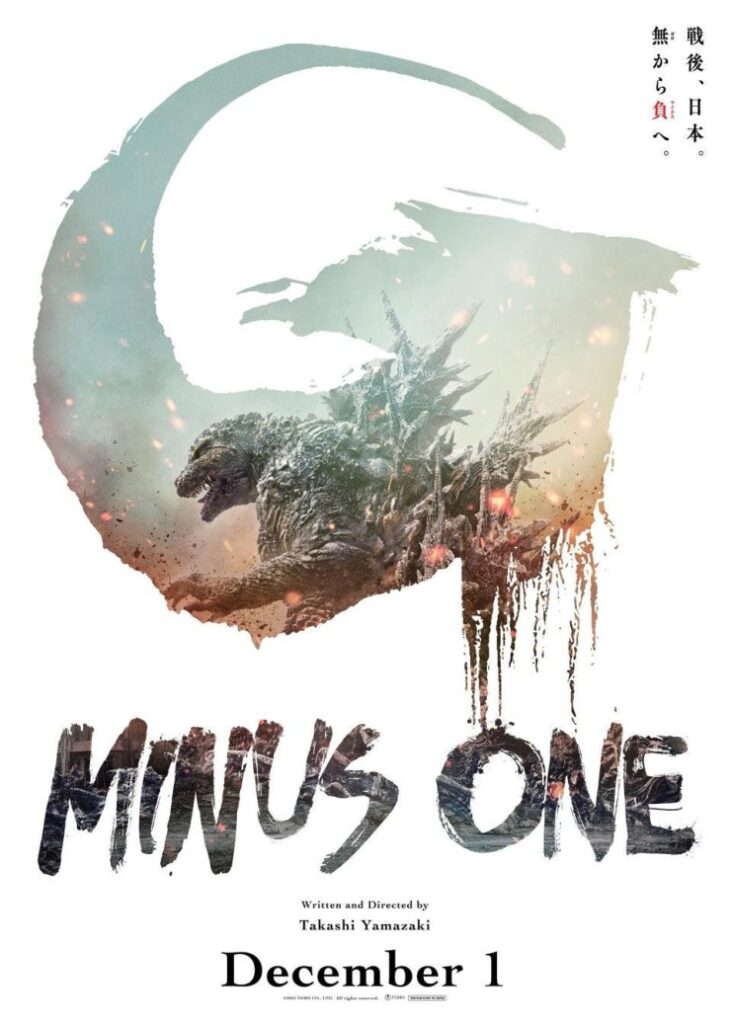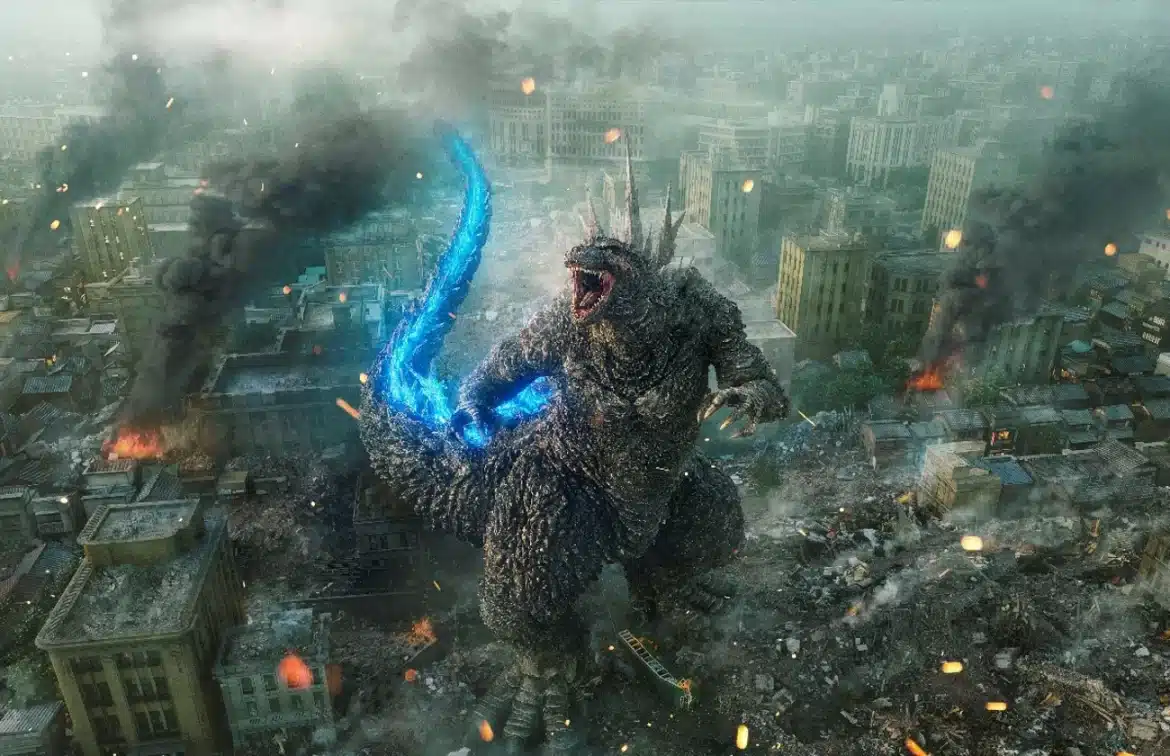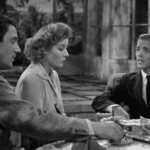Godzilla has a long storied history in film, 70 years to be precise, and with each iteration of the Godzilla we are given different perspectives on Japan, Japanese history, the impacts of war, raditation, and nuclear power, the workings (or often failure) of beaucracy, and increasingly with Western adaptations we’re given blockbusters that may allude to such thoughts but often just present themselves as rollicking action flicks. This means some Godzilla films are great, some are more miss than hit, some are late-night popcorn fodder for comic send-ups, and some are just forgetable entirely. I think it’s fair to say everyone has a different relationship with Godzilla, depending on which we’ve seen, and though mine’s been incredibly positive, as a fan of several of these films, I was still unprepared for the majesty of Godzilla Minus One.
Synopsis:
On an isolated air base on Odo Island in World War II, the kamikaze pilot Kōichi Shikishima lands on the base for the airmen to repair his plane; however, they find no damage and question Kōichi’s reason for landing, implying cowardice. Kōichi rejects the accusation. That night Kōichi and the crewmen are surprised when a monster, known by the locals as Godzilla, who attacks the base. Kōichi, scarred by the encounter, then returns to Tokyo, a city that’s been firebombed by the Americans leaving neighborhoods destroyed and thousands dead including his neighbor’s kids and his own parents. His neighbor blames him as a failed Kamikaze pilot for not sacrificing himself to save the war. Kōichi is lost, but he does help save a young baby, and the girl who has been protecting her, and together they try to fend for themselves. Eventually this fragile post-war peace is fractured for Kōichi and Japan, as Godzilla rises up and attacks Tokyo. Together Kōichi and others must find a way to fight off this new threat.
‘Godzilla Minus One’ Review:

Ryunosuke Kamiki as Kōichi Shikishima in ‘Godzilla Minus One’ (Source: Toho Co., Ltd.)
From the jump it’s clear Takashi Yamazaki, the writer and director of ‘Godzilla Minus One’, understood the assignment when developing his 70th anniversary film to celebrate Godzilla. After all Yamazaki begins the film on Odo Island, referenced in the very first Godzilla film, and the connections only continue from there. Though less explicilty stated, as Godzilla’s origin in this film is unclear, his growth and strength is, as in the first film, tied to Operation Crossroads, a set of real nuclear tests conducted at Bikini Atoll, along with other hydrogen bomb tests. Perhaps most explicitly the connection of post-war Japan, and in particular anti-war themes, run throughout both films as well.
What sets this film apart however is the way these themes are portrayed and then turned on their head. At first you’d be forgiven for thinking ‘Godzilla Minus One’ was out to champion the Japanese nationalism of the time, with Kōichi’s failure as a kamikaze so frequently on display. He himself is scarred more by his failure than by Godzilla, believing his sacrifice to be needed to attone for all he failed to save by living. Very quickly though its clear that as time progresses, and this movie covers a longer stretch of time than I’d have expected, you see the evolving view of the survivors of the war and the increasing blame put on the Japanese government. Yamazki in fact devotes entire monologues and conversations to this notion, as one character says the Japanese are incredible at limited information from reaching its citizens, a notion that very directly attacks the era and the government of Japan during WWII. Though the original Godzilla, released less than 10 years after the war, was still an incredible political statement, Yamazaki with ‘Godzilla Minus One’ goes harder, and more precise, with his critiques of the era.
One feature that runs throughout many of the best Godzilla films, and this is true here as well, is the focus on the people at the center of the fight. Though Godzilla’s name is on the marquee, in Godzilla films the creature is often relegated to appear only when needed to push the heroes along and at the end of the film for a grand confrontation. This means most of the time we are left with a focus on the citizens and various militeray personnel fighting back. Oftentimes its bueracrats, politicians, and active military we follow, but in this film our main characters are largely war weary vets and citizens just doing their best for their families in a post-war Japan that’s reeling. In many ways, they’re still cleaning up the mess of the war they were in, which is quite literal for Kōichi and his co-workers who run a salvage boat that’s been set out to clear up mines from the war. For them the danger is real still as the bring in the mines to be destroyed. They are also on the front lines when Godzilla attacks, and thus are integral into combatting the monster together, yet another remnant thanks to the H-Bombs of the war. By placing them at the center, Yamazaki again reclaims the narrative from WWII that so often centers the government of Japan, which directed its many citizens to arms, and returns focus to those trying to just survive.
This notion of survival is key and one of the most impactful parts of ‘Godzilla Minus One’. Where other directors, and certainly the propaganda machine at the time, might use death as the crux of this film, Yamazaki chooses life. On its surface you might expect this to result in cheesy sequences, that are emotionally unearned; however, it’s the exact opposite of that in Yamazaki’s hands. Instead life is power to fight another day, to face the greatest of foes, and to charge ahead through all of life’s uncertainties. This notion is why even in among the many incredible Godzilla films over the years, ‘Godzilla Minus One’ rises quickly to the top or very near, and is a true milestone not just in genre filmmaking, or in the franchise, but in film itself.










